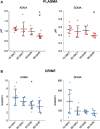Urinary excretion of asymmetric (ADMA) and symmetric (SDMA) dimethylarginine is positively related to nitric oxide level in tissues of normotensive and hypertensive rats
- PMID: 36802034
- PMCID: PMC10140227
- DOI: 10.1007/s00726-023-03246-9
Urinary excretion of asymmetric (ADMA) and symmetric (SDMA) dimethylarginine is positively related to nitric oxide level in tissues of normotensive and hypertensive rats
Abstract
Nitric oxide (NO) is one of the gaseous transmitters which play a very important role in the regulation of the circulatory system. Decreased NO availability is associated with hypertension, cardiovascular and kidney diseases. Endogenous NO is generated enzymatically by nitric oxide synthase (NOS) depending on the availability of the substrate, cofactors, or presence/absence of inhibitors, such as asymmetric dimethylarginine (ADMA) and symmetric dimethylarginine (SDMA). The objective of this study was to evaluate the potential relationship between NO level in rat tissues (heart and kidneys) and the concentrations of endogenous metabolites related to NO in plasma and urine. The experiment was carried out with 16- and 60-week-old male Wistar Kyoto (WKY) and age-matched male Spontaneously Hypertensive Rats (SHR). NO level in tissue homogenates was determined by the colorimetric method. RT-qPCR was used to verify the expression of the eNOS (endothelial NOS) gene. Plasma and urine concentrations of arginine, ornithine, citrulline, and dimethylarginines were examined by the UPLC-MS/MS method. 16-week-old WKY rats had the highest tissue NO and plasma citrulline levels. Furthermore, 16-week-old WKY rats showed higher urinary excretion of ADMA/SDMA compared to other experimental groups, however, plasma concentrations of arginine, ADMA, and SDMA were comparable between the groups. In conclusion, our research shows that hypertension and aging decrease tissue NO levels and are associated with reduced urinary excretion of NOS inhibitors, i.e., ADMA and SDMA.
Keywords: Aging; Asymmetric dimethylarginine (ADMA); Hypertension; Nitric oxide; Symmetric dimethylarginine (SDMA).
© 2023. The Author(s).
Conflict of interest statement
The authors declare no competing interests.
The authors declare no conflict of interest.
Figures






Similar articles
-
Two different approaches to restore renal nitric oxide and prevent hypertension in young spontaneously hypertensive rats: l-citrulline and nitrate.Transl Res. 2014 Jan;163(1):43-52. doi: 10.1016/j.trsl.2013.09.008. Epub 2013 Oct 8. Transl Res. 2014. PMID: 24113064
-
The combined ratios of L-arginine and asymmetric and symmetric dimethylarginine as biomarkers in spontaneously hypertensive rats.Transl Res. 2012 Feb;159(2):90-8. doi: 10.1016/j.trsl.2011.09.002. Epub 2011 Sep 29. Transl Res. 2012. PMID: 22243793
-
Melatonin prevents hypertension and increased asymmetric dimethylarginine in young spontaneous hypertensive rats.J Pineal Res. 2010 Nov;49(4):390-8. doi: 10.1111/j.1600-079X.2010.00806.x. Epub 2010 Sep 9. J Pineal Res. 2010. PMID: 20950359
-
Toxic Dimethylarginines: Asymmetric Dimethylarginine (ADMA) and Symmetric Dimethylarginine (SDMA).Toxins (Basel). 2017 Mar 6;9(3):92. doi: 10.3390/toxins9030092. Toxins (Basel). 2017. PMID: 28272322 Free PMC article. Review.
-
Asymmetric (ADMA) and Symmetric (SDMA) Dimethylarginines in Chronic Kidney Disease: A Clinical Approach.Int J Mol Sci. 2019 Jul 26;20(15):3668. doi: 10.3390/ijms20153668. Int J Mol Sci. 2019. PMID: 31357472 Free PMC article. Review.
Cited by
-
SDMA as a marker and mediator in cerebrovascular disease.Clin Sci (Lond). 2024 Oct 16;138(20):1305-1323. doi: 10.1042/CS20241021. Clin Sci (Lond). 2024. PMID: 39391895 Free PMC article. Review.
References
-
- Achan V, Broadhead M, Malaki M, Whitley G, Leiper J, MacAllister R, Vallance P. Asymmetric dimethylarginine causes hypertension and cardiac dysfunction in humans and is actively metabolized by dimethylarginine dimethylaminohydrolase. Arterioscler Thromb Vasc Biol. 2003;23(8):1455–1459. doi: 10.1161/01.ATV.0000081742.92006.59. - DOI - PubMed
MeSH terms
Substances
LinkOut - more resources
Full Text Sources
Medical

